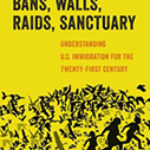The Violence Inside Us: A Brief History Of An Ongoing American Tragedy

Author: Chris Murphy
Publisher: New York: Random House, 2020. 384p.
Reviewer: Randolph Roth | February 2021
Senator Chris Murphy has written a moving, very well-researched book on the problem of violence in the United States. It’s gripping when he writes about citizens from his home state, Connecticut, whose lives have been touched or ended by violence in and around Waterbury and Hartford; and it’s heart-rending when he writes of his experiences as a public official, trying to console people from around the country who have lost loved ones to mass shootings. When he writes about campaigns for meaningful reform it’s inspiring. Yet The Violence Inside Us is also a wise and informative introduction to the work that scholars and practitioners have done to understand and deter violence and to the public policy initiatives that would build upon that work. In short, it is a timely book that only a person with Murphy’s broad experience and deep knowledge of government and public policy could write.
Scholars who study violence will be familiar with the literatures Murphy cites on the biology, sociology, and history of violence, but that is a good thing. Murphy and Victoria Bassetti, his co-researcher, have read widely and well. They engage the literature and weigh in thoughtfully on just about every scholarly debate. (Scholars be advised—you will win a few and lose a few in The Violence Inside Us, as I did, but always for reasons that are thoughtful, respectful, and clear.)
The book is clearly structured. Murphy begins by outlining the problem in “SOS”—a chapter “on the searing pain and bottomless loss” caused by violence in America and the need to “rise up” and do something about it (24-25). In subsequent chapters, he discusses the causes of mass shootings (“The Violence We See”), everyday violence (“The Violence We Ignore”), and the violence of American foreign policy (“The Violence We Export”). Those chapters are followed by policy chapters on “Curbing the Means of Violence” and “Pulling Out the Roots of Violence.” Every one of these chapters is strong.
Murphy focuses first on mass shootings. He emphasizes the fact that few mass shooters are delusional or otherwise profoundly mentally ill. Nearly all, in his words, are “pseudo commandos” who wallow in self-pity until their “feeling of exclusion and resentment . . . explodes.” Their “intense sense of persecution and mistreatment” flows, in his opinion, from two historical trends that will be hard to change through public policy: first, “the growth in the value of self-admiration and personal celebrity that has spread like a virus” over the past fifty years; and second, “the growing narcissism of younger generations of Americans” (126-127).
I’m not certain, as a historian, that this portrait of America’s recent cultural history is sound. But otherwise, Murphy’s grasp of the psychology of the majority of mass shooters is sure, as is his argument that the best way to prevent mass killings is to deprive would-be mass murderers of technologies that give lone individuals the power to kill masses of people in minutes.
Murphy is aware of the irony of America’s response to mass murders. The 9/11 attack led to measures that have made it nearly impossible to commandeer a plane. The Oklahoma City bombing made it impossible for private individuals to buy five tons of fertilizer unless they are farmers. And of course, since the 1930s, federal law has made it impossible to purchase dynamite unless you are a miner or contractor. But semi-automatic weapons with large capacity magazines are still widely available and remain attractive to potential mass murderers, who fantasize about topping the body counts of previous mass murderers.
Murphy is a firm advocate of universal background checks, red-flag laws, and bans on the most lethal magazines and firearms. He notes, in a brief history of the National Rifle Association, that even the NRA used to be on the side of such reasonable laws, until the steep decline in gun ownership in the United States forced the arms industry to survive by selling more and more dangerous guns to fewer and fewer people. Today, half of all firearms in America are owned by only three percent of all Americans, each with an average “personal arsenal of seventeen guns a piece” (147).
The next chapter is on violence rooted in poverty and despair: street crime, domestic violence, and suicide. Murphy finds great merit in the Kerner Commission report of 1968, which cited three reasons for the toll of everyday violence in the United States: (1) concentrated poverty, (2) “a racist power structure that systematically denied” African Americans economic opportunities, adequate housing, and access to basic services, and (3) “the violent and illegal behavior of white communities,” from terrorism and police brutality to segregation and suppression of peaceful protests, which undermined the legitimacy of American institutions among the poor and disfranchised and forced them to settle differences among themselves, sometimes violently, because they did not trust the justice system (159).
In Murphy’s opinion, these problems can be addressed only through a renewed War on Poverty, a commitment to rebuild the economies of cities and rural communities hard hit by globalization and deindustrialization, and a campaign for civil rights and racial justice. Murphy also calls for an end to mass incarceration, to the destructive aspects of the War on Drugs, and to loopholes that have given unscrupulous gun dealers the ability to sell guns to violent offenders with impunity.
The next chapter is on the violence that the United States has spread around the world. Murphy questions a foreign policy “that seeks to quell violence with more violence” (161). He decries drone warfare, the “futility of our missions” in Iraq and Afghanistan, and U.S. support for the Saudis’ near-genocidal war against the Houthis in Yemen (206). But he reserves special condemnation for the “lethal hardware pushed by profit-oriented military-industrial companies mostly unconcerned about the consequences. Military-grade firearms that are vacuumed out of America and delivered to the most dangerous countries in the world as fast as smugglers can export them from unregulated American gun shows” (231).
In the final chapters, Murphy takes up public policy. His discussion of the effectiveness of gun regulations and anti-poverty measures is thoughtful and persuasive. And his stories about the difficulties of passing the requisite legislation are humane and good-humored.
My only quibbles—and they are indeed quibbles, rather than complaints—concern the chapters on the biology and history of violence. Murphy’s chapter on biology focuses on hard-wired human propensities for violence, “especially the instinct to revert to violence against outsiders.” The chapter discusses the design of male bodies, “emotional systems” that trigger fear and rage, and “deficits” in the brains of a disproportionate number of violence offenders that interfere with their capacity to empathize with others and control their impulses.
This argument is sound, but it is not cutting edge. There is much new research that shows how our bodies respond to historical circumstances that may facilitate or deter hostile, defensive, or predatory emotions. Endocrinologists, neurologists, and geneticists have proved that our propensity for violence can change dramatically over time and across social space because of changes in the levels of hormones or in epigenetic triggers that turn certain genes on or off. Humans are “hard wired” not only for aggression, but for cooperation and fellowship, depending on the situations in which they find themselves. So it seems antiquated to refer to “human nature,” now that scientists understand how changeable humans are.
Then there is the author’s embrace of Norbert Elias’s “civilization thesis,” which is based on the premise that violence has declined precipitously (and almost steadily) from prehistoric times down to the present. Elias believed that this “decline” was caused by the invention of manners (which taught self-control and self-restraint), interdependence born of advances in commerce and education (which taught empathy, understanding, and the need for harmonious relations), and the rise of powerful states with monopolies on violence (states that could punish and protect others from the violent).
Murphy argues that the United States deviated from that downward path in three waves (1840-1860, 1865-1935, and 1965-1995). It did so for two major reasons. First, America has enormous diversity in religion, language, national origins, and skin color. The “constant inflow of new peoples comes with a friction and a never-ending, constant, and open battle for supremacy among these different groups. . . . America’s violence problem is rooted, first and foremost, in violence erupting as in-groups and out-groups fight for finite social and economic territory in tight spaces.” And second, America has a massive supply of guns. “Guns, and their liberal usage, have been built into the fabric of America from the beginning, and there is no way to tell the story of American violence without placing much of the blame on the widespread marketing and ownership of these highly lethal weapons” (66-67).
The difficulties with the “civilization” thesis are many—so many that a recent issue of Historical Reflections (2018) was dedicated to pushing back against its claims, in particular its refusal to acknowledge that the period from 1890 to 1953 was in all likelihood the most lethal era in human history when it comes to the number and proportion of the world’s population killed. Manners, education, commerce, and strong states did not prevent that violence. Indeed, to an unnerving degree, they facilitated it. And America’s diversity and penchant for firearms have not in every circumstance led to violence. In the early nineteenth century, for instance, when at least half of all households owned a working gun, and the nation was already fairly diverse, the North and the mountain South had perhaps the lowest homicide rates in the Western world, even though the slave South was brutally violent. History is complicated in ways that frustrate every effort, however well-intentioned, to simplify it.
That is not to say, however, that Murphy is wrong about America today. If Americans were to see one another as fellow Americans, regardless of the differences among us, we would be less violent. If we could trust one another and our institutions, we would be less violent. If we could create a society in which everyone could succeed, regardless of race or access to education and inherited wealth, we would be less violent. And if we were less hostile, defensive, and fearful in the presence of our fellow Americans, we would buy fewer firearms and would use those we owned in a more responsible manner.
And let us not forget that the United States has made progress on some fronts. The revolution in gender relations that began in the 1960s and early 1970s led in the short run to a spike in male violence against women. But in the long run, it has led to lower levels of violence against women, as more and more men have accepted or embraced the ideal of gender equality, and as sympathy and support for victims of domestic violence have increased. The shocking increase in gun violence in the 1960s and early 1970s, and the growing awareness of the causal connections between firearms ownership, suicides, and accidents, turned Americans away from guns over the past forty-five years. Firearms ownership has declined steadily since the mid-1970s, from half of all households to a third or less today, in parallel with a steady decline in armed robberies and homicides of persons twenty-five and older. These successes are signs of successful nation-building—of the degree to which Americans can build a strong, stable, inclusive, and trusting nation that respects and responds to the growth of knowledge. Senator Murphy’s book will add to that knowledge.
Reference
“History, Violence, and Steven Pinker,” special issue, Historical Reflections 44: 1 (2018).
Randolph Roth, Professor of History and Sociology, Ohio State University


